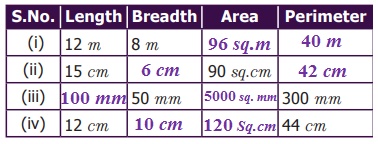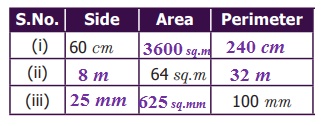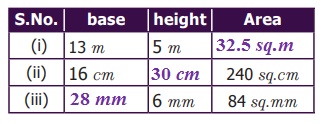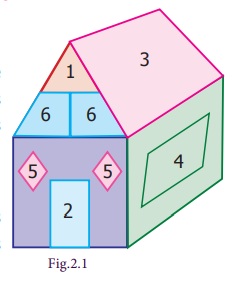Term 1 Chapter 2 | 7th Maths - Measurements | 7th Maths : Term 1 Unit 2 : Measurements
Chapter: 7th Maths : Term 1 Unit 2 : Measurements
Measurements
Chapter 2
MEASUREMENTS

Learning Objectives
● To recall the concepts of perimeter and area
of square, rectangle, right angled triangle and combined shapes.
● To understand and find the area and perimeter
of parallelogram, rhombus and trapezium.
Recap
In ancient days people used non-standardised
measures such as cubit, king’s foot, king’s arm and yard etc. Later, people
realised the need for standardised units and International System of Units
which were introduced in the year 1971.

The SI Units of various measures are shown in
the table
In Class VI, we studied about area and
perimeter of rectangle, square and right angled triangle.
Perimeter is the distance around and Area is the region occupied by the
closed shape.
Try these :
Find the missing values for the following:

Hint:
The perimeter of a
rectangle = 2 × (l + b) units.
Area of a rectangle = l × b square units.
(l and b are length
and breadth of a rectangle)

Hint:
Perimeter of a
rectangle = 1 × a units
Area of a square = a × a square units.
('a' is the side of
the square)

Hint:
Area of the right
angled triangle = 1/2 (b × h) square units
(‘b’ is the base and ‘h’ is the height of the triangle)
Introduction
We have studied area of four sided shapes such
as square and rectangle. Do you think that all the four sided shapes will
happen to be square or rectangle? Think!
Let us learn about some more four sided shapes
that we see around us through the conversation that follows.
Observe the shapes found in the
figure
Teacher : Can you tell me the name of the
shapes that you see in the figure?
Student : Yes teacher, there is a triangle, square and rectangle
Teacher : What is the shape, numbered 4 in the figure?
Student : The shape looks like a rectangle because the opposite sides
are equal and parallel but the adjacent sides do not make right angle. Can we
call such shapes as rectangles?
Teacher : Even though the opposite sides are equal and parallel, the
adjacent sides do not make right angles instead they make acute and obtuse
angles. This shape has a special name called
parallelogram.

Student : Teacher, can you tell me about shape,
numbered 5?
Teacher : Try to tell the properties that you
know, then I will help you.
Student : Shape 5 has all the sides equal and
looks like a square but the adjacent sides do not make right angles. Is there
any special name for such shapes.
Teacher : Yes, it has a special name called rhombus. What about the shape, numbered 6?
Student : Shape 6 does not have any of the
properties of square and rectangle. But one pair of opposite sides are
parallel. Does this also have a different name?
Teacher : Yes, it is called trapezium.
Now, let us learn about all the three new
shapes namely parallelogram, rhombus and trapezium.
Related Topics